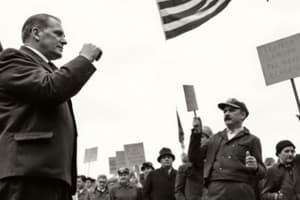Podcast
Questions and Answers
Who is Jane Addams?
Who is Jane Addams?
The founder of Hull House, which provided English lessons for immigrants, daycares, and child care classes.
What was the American Federation of Labor founded for?
What was the American Federation of Labor founded for?
- To advocate for skilled laborers' rights (correct)
- To create a national union
- To promote socialist ideas
- To increase immigration
What was the purpose of the American Protective Association?
What was the purpose of the American Protective Association?
To campaign for laws to restrict immigration.
The Chinese Exclusion Act allowed Chinese laborers to freely enter the United States.
The Chinese Exclusion Act allowed Chinese laborers to freely enter the United States.
What does 'Conspicuous Consumption' refer to?
What does 'Conspicuous Consumption' refer to?
What was the aim of the Dawes Act?
What was the aim of the Dawes Act?
What was the Ghost Dance Movement?
What was the Ghost Dance Movement?
What does the Gospel of Wealth advocate?
What does the Gospel of Wealth advocate?
What was the Grange Movement?
What was the Grange Movement?
What are holding companies?
What are holding companies?
What did the Interstate Commerce Act establish?
What did the Interstate Commerce Act establish?
Who was J.P. Morgan?
Who was J.P. Morgan?
What did the Knights of Labor aim to achieve?
What did the Knights of Labor aim to achieve?
Laissez-faire economics advocates for government intervention in the economy.
Laissez-faire economics advocates for government intervention in the economy.
What occurred at Little Big Horn?
What occurred at Little Big Horn?
Who was Mother Jones?
Who was Mother Jones?
What was the National Woman Suffrage Association?
What was the National Woman Suffrage Association?
What were the main demands of the Populist Party?
What were the main demands of the Populist Party?
The Plessy vs. Ferguson case upheld the principle of 'separate but equal' facilities.
The Plessy vs. Ferguson case upheld the principle of 'separate but equal' facilities.
What were the aims of the Progressive Reformers?
What were the aims of the Progressive Reformers?
Who was John D. Rockefeller?
Who was John D. Rockefeller?
What role did Elizabeth Cady Stanton play in history?
What role did Elizabeth Cady Stanton play in history?
Study Notes
Key Individuals and Movements
- Jane Addams: Founded Hull House, offering English lessons, daycares, and childcare classes to immigrants.
- Samuel Gompers: Established the American Federation of Labor in 1886 to advocate for better wages, hours, and working conditions, focusing on skilled laborers while rejecting socialist ideologies.
- Mother Jones: Labor activist and member of the Knights of Labor, used media to highlight the struggles of mine workers and child laborers.
- John D. Rockefeller: Founder of the Standard Oil Company, revolutionized the oil industry and established practices of modern philanthropy.
- Elizabeth Cady Stanton: Key figure in the women's suffrage movement, co-founded the National Woman Suffrage Association.
Legislation and Acts
- Chinese Exclusion Act (1882): Prohibited the entry of additional Chinese laborers, allowing only students and merchants, due to American workers fearing job competition.
- Dawes Act (1887): Aimed to assimilate Native Americans by dismantling tribes and distributing land to individuals as family heads.
- Interstate Commerce Act: Established the Interstate Commerce Commission to regulate railroad prices and monitor business operations across states.
- Plessy vs. Ferguson: Supreme Court ruling that upheld "separate but equal" policies, effectively legalizing segregation.
Organizations and Social Movements
- American Protective Association: Nativist organization founded in 1887 focused on restricting immigration.
- American Federation of Labor: Aimed for worker rights through non-violent strikes and rejection of socialist ideals.
- Knights of Labor: Early national union including various laborers, faced challenges due to vague goals and weak leadership.
- Grange Movement: Social and educational organization for farmers to combat railroads' power in the late 19th century.
- Populist Party (1891): Advocated for monetary reform, regulation of railroads, and direct elections to address farmer grievances.
Economic Concepts
- Laissez-faire Economics: Government non-interference in the economy, promoting free-market principles.
- Holding Companies: Corporations that control other companies’ stocks to maintain monopolistic control, targeted by the Clayton Anti-Trust Act.
Cultural Aspects
- Conspicuous Consumption: Purchasing expensive products to display wealth and status.
- Gospel of Wealth: Andrew Carnegie's philosophy that the wealthy have a responsibility to engage in philanthropy, contrasting Social Darwinism.
Significant Historical Events
- Massacre at Wounded Knee: Resulted from the suppression of the Ghost Dance Movement, symbolizing the end of Native American resistance.
- Battle of Little Big Horn: General Custer's defeat by Sioux and Cheyenne forces, marking a significant Native American victory.
Social Changes
- Progressive Reformers: Sought societal improvements through government action and interventions during the late 19th and early 20th centuries.
Studying That Suits You
Use AI to generate personalized quizzes and flashcards to suit your learning preferences.
Description
Explore significant figures and movements that shaped U.S. history, from Jane Addams' social reforms to Elizabeth Cady Stanton's activism for women's rights. This quiz covers key legislation like the Chinese Exclusion Act and influential labor leaders such as Samuel Gompers. Test your knowledge of these pivotal historical elements.




